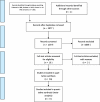Inflammatory biomarkers in patients with sciatica: a systematic review
- PMID: 30967132
- PMCID: PMC6456959
- DOI: 10.1186/s12891-019-2541-0
Inflammatory biomarkers in patients with sciatica: a systematic review
Abstract
Background: This systematic review focusses on inflammation as an underlying pathogenic mechanism in sciatica. We addressed two questions in particular: (1) what inflammatory biomarkers have been identified in patients with sciatica in the literature so far? 2) is there an association between the level of inflammatory activity and clinical symptoms?
Methods: The search was conducted up to December 19th 2018 in MEDLINE, EMBASE, CENTRAL and Web of Science. The study selection criteria: (1) observational cohort studies, cross-sectional studies and randomized clinical trials (RCT), (2) adult population (≥ 18 years) population with sciatica, (3) concentrations of inflammatory biomarkers measured in serum, cerebrospinal fluid (CSF) or biopsies, and (4) evaluation of clinically relevant outcome measures (pain or functional status). Three reviewers independently selected studies and extracted data regarding the study characteristics and the outcomes. Risk of Bias was evaluated using an adjusted version of the Quality in Prognosis Studies (QUIPS) tool.
Results: In total 16 articles fulfilled the criteria for inclusion: 7 cross sectional observational studies and 9 prospective cohort studies that included a total of 1212 patients. With regard to question 1) the following markers were identified: interleukin (IL)-1β, IL-2, IL-4, IL-6, IL-8, IL-10, IL-17, IL-21, tumor necrosis factor-α (TNF-α), phospholipase A2, high sensitivity C-reactive protein (hsCRP), C-X-C motif chemokine 5 (CXCM5), CX3CL1, CCL2, epidermal growth factor (EGF), and monocyte chemotactic protein 4 (MCP-4). With regard to question 2) several positive correlations were found in longitudinal studies: a strong positive correlation between inflammatory mediators or byproducts and pain (measured by visual analogue scale, VAS) was found for IL-21 in two studies (r > 0,8), and moderate positive correlations for TNF-a in both serum (r = 0,629) and biopsy (r = 0.65); severe pain (VAS > 4) is associated with increased hsCRP levels among patients with sciatica (adjusted OR = 3.4 (95% CI, 1.1 to 10).
Conclusion: In this systematic review there was considerable heterogeneity in the type of biomarkers and in the clinical measurements in the included studies. Taking into account the overall risk of bias of the included studies there is insufficient evidence to draw firm conclusions regarding the relationship between inflammation and clinical symptoms in patients with sciatica.
Keywords: Biomarkers; Cytokines; Inflammation; Interleukin; Lumbar disc herniation; Sciatica; Systematic review.
Conflict of interest statement
Ethics approval and consent to participate
“Not applicable” (literature study).
Consent for publication
“Not applicable” as our manuscript does not contain any individual person’s data in any form.
Competing interests
The authors declare that they have no competing interests.
Publisher’s Note
Springer Nature remains neutral with regard to jurisdictional claims in published maps and institutional affiliations.
References
-
- Spijker-Huiges A, Groenhof F, Winters JC, van Wijhe M, Groenier KH, van der Meer K. Radiating low back pain in general practice: incidence, prevalence, diagnosis, and long-term clinical course of illness. Scand J Prim Health Care. 2015;33(1):27–32. doi: 10.3109/02813432.2015.1006462. - DOI - PMC - PubMed
-
- Porchet F, Wietlisbach V, Burnand B, Daeppen K, Villemure JG, Vader JP. Relationship between severity of lumbar disc disease and disability scores in sciatica patients. Neurosurgery. 2002;50:1253–1259.5. - PubMed
-
- El Barzouhi A, Vleggeert-Lankamp CL, Nijeholt GJ LÀ, Van der Kallen BF, van den Hout WB, Jacobs WC, Koes BW, Peul WC, Leiden-The Hague Spine Intervention Prognostic Study Group Magnetic resonance imaging in follow-up assessment of sciatica. N Engl J Med. 2013;368(11):999–1007. doi: 10.1056/NEJMoa1209250. - DOI - PubMed
Publication types
MeSH terms
Substances
LinkOut - more resources
Full Text Sources
Medical
Research Materials
Miscellaneous


